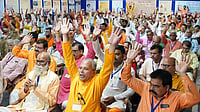Just like Italian explorer Christopher Columbus mistook America for India when he made landfall on the continent in 1492, Portuguese adventurer Vasco da Gama also made a similar error in judgement when he rounded the Cape of Good Hope and landed in Calicut on the Asian subcontinent, just six years later in 1498. When da Gama landed along the Malabar coast, the natives took him to a Hindu temple in Calicut, where, according to historian Alexander Henn, he mistook the deity for Mother Mary.
“In particular, he persistently mistook the Hindus he met there for Christians. Hence, we can reconstruct from the report of his first voyage that da Gama went to a Hindu temple in Calicut that he mistook for a Christian church and prayed there in front of a Hindu image that, he believed, portrayed the most Catholic figure of ‘Our Lady’. The details of their description clearly indicate that they had not been visiting a Christian church, but a Hindu temple in Calicut…” Henn says in his book Hindu-Catholic Encounters in Goa Religion, Colonialism and Modernity.
Both Columbus and da Gama perhaps were victims of scotomisation, a psychological condition, according to which the mind makes one see what one wants to see and shies away from other realities. Just like Goa (and other parts of the country) in circa 2022, politics combined with a more searing strain of scotomisation and a dash of religion has manufactured a narrative of restoration of Hindu religious structures in an orchestrated bid to ‘correct’ past religious wrongs. The Goa government’s latest but still undefined thrust on reconstruction of temples destroyed during the early colonial Portuguese regime, comes on the heels of similar flash-points in the country under the broad construct of Hindu revivalism. In his budget speech this year, chief minister Pramod Sawant allocated Rs 20 crore for restoration of “cultural centres” which were destroyed by the colonists. “Our places of worship are symbols of our rich cultural heritage. At many places in Goa, we find several temples in a dilapidated and neglected condition. During the Portuguese regime, there was a systematic effort to destroy these cultural centres,” Sawant said.

The lack of specifics and the vague reference to “cultural centres” has led the opposition to point out the lack of clarity in his announcement. “The chief minister’s plan to reconstruct temples may not be objectionable, but spending Rs 20 crore of taxpayers’ money without a policy or parameters is objectionable. Lay down a policy and not merely make statements in the air to please your bosses,” Goa Trinamool Congress leader Trajano D’Mello said.
Excesses committed by the Portuguese military and Catholic missionaries together are documented history. The estimated destruction of hundreds of temples in areas like Bardez, Salcete and island territories initially conquered by the Portuguese, according to Henn, was part of “iconoclastic policies articulated in the legislation issued by various Portuguese kings in Lisbon in the middle decades of the sixteenth century” and undoubtedly were of the utmost ruthlessness and aimed at the complete destruction of the religious culture of Hindus in the extended Goa” in order to promote Christianity in the new world. “An early indication that the campaign had devastating effects in the islands of Goa comes from Nicollo Lancilotto, a visiting Italian Jesuit, who on his arrival in 1545 reported, ‘there are no more temples in this island, but there remains an infinite number of moors, gentiles and bad Christians’,” says Henn. The author also adds that it was not easy to “determine the damage of the iconoclastic campaign” because of insufficient and indirect information about the “number and the quality of temples that existed in Goa before the arrival of the Portuguese”.

Bishop Duarte Nunez, who led the first major delegation of high-ranking clergy to Goa in 1522, soon after Afonso de Albuquerque’s successful conquest, also wrote to Portuguese ruler King João III, advocating destruction of Hindu temples and replacing them with churches. “Regarding the people of Goa, they have in their island their temples decked out with figures of the enemy of the Cross and [?] statues, and they celebrate their feasts every year; these feasts are attended by many Christians, our own people as well as recent native Christians. It is a big mistake to continue to show favour to their idolatry. It would be to the service of God to destroy in this island alone these temples and to raise in their stead churches with saints. And whoever wants to live in this island let him become a Christian and he shall possess his lands and houses as he has till now done; if he does not want to do so, let him leave the island,” Henn quotes Nunez’s letter in his book.
Nunez’s imploration for razing of temples predates the dreaded Inquisition of 1560 that advocated a violent campaign against Protestants and the neo-Catholics. The mortal remains of the initiator of the Inquisition, a Spanish Jesuit priest named Francis Xavier, lie entombed in the Se Cathedral in Goa. Centuries later, the annual feast of St. Francis Xavier has evolved as a more universal tradition in which Catholics and a small section of Hindus and Muslims also participate. But the aggressive debate over reconstruction of temples destroyed in the colonial times has raised questions over Xavier’s informal, but widely articulated status as the patron saint of Goa.
“Xavier, through the Goa Inquisition, committed atrocities on Goans. He is responsible for it. People suffered atrocities and were suppressed. We want to bring this before the people of Goa,” according to former state Rashtriya Swayamsevak Sangh chief Subhash Velingkar, who earlier this month released the Goa Files, a collection of already available historical documents linked to the Inquisition.
While the issue of temple restoration presents itself as a lively yeast for conservative political camps in Goa to ferociously knead their own Hindu and Catholic narratives with an eye on the 2024 electoral cake, historians like Dr Rohit Phalgaonkar have urged caution and advocated incorporation of pragmatism in the exercise. “…Whatever has happened, has happened in the past, we cannot undo it. We have to take it as history and it has to be studied very objectively. I cannot go with a pickaxe and start breaking down things and say this is not right so let us undo it,” Phalgaonkar says, calling for a dispassionate survey or documentation of ancient remains in the state. He also makes a mention of how idols in old Hindu temples are discarded carelessly after renovation. “Temples are pulled down without considering heritage and historic aspects of it. The broken images are just discarded like anything, which were once worshipped and they are the evidence of the past,” he adds.
Chief minister Sawant, however, insists that rejuvenation of temples destroyed by the Portuguese would set the foundation for “cultural and spiritual tourism” in Goa’s hinterlands. “In every village, there are a couple of temples. We have to take people from the beach to the temple,” Sawant told the Organiser-Panchjanya Media Conclave in Delhi on Sunday. Herding people from the state’s beaches may prove to be easier than chaperoning the hundreds of thousands of tourists who flock every year to Goa’s new-age ‘temples of tourism’—casinos—which are a dubious legacy left behind by Congress and BJP governments in the state and have little to do with the colonial past.
(This appeared in the print edition as "Past Imperfect, Present Tense")
Mayabhushan Nagvenkar is the Goa correspondent for the Indo-Asian News Service



























